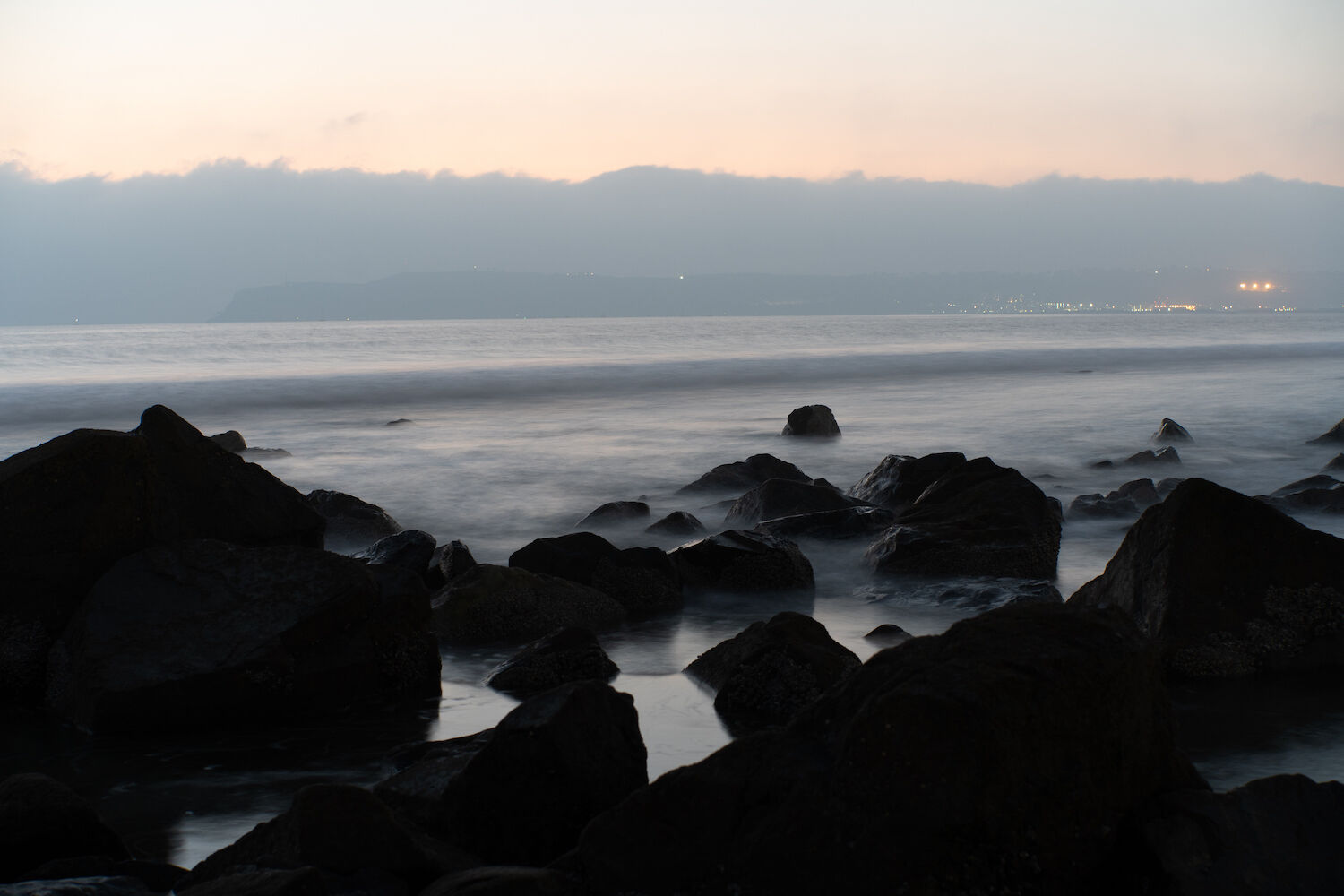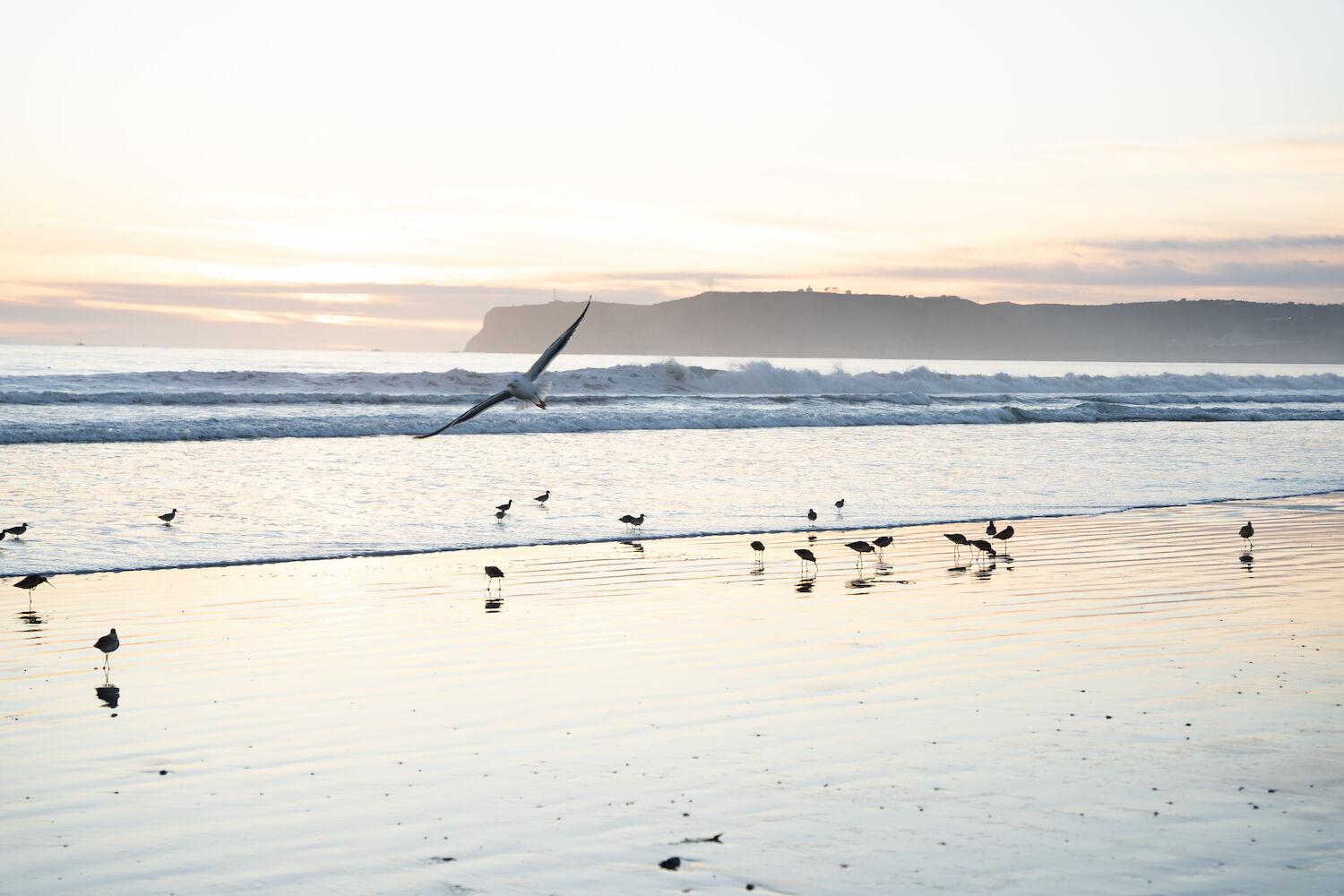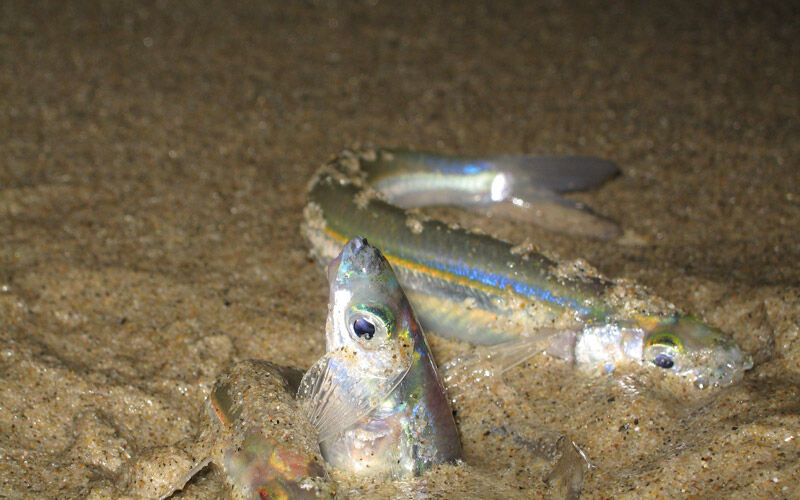
San Diego Grunion Run 2023 Fish Beaches Coronado – 2
Photo Credit: Cole Novak
For four nights in a row, following a full or new moon in the spring and summer months—when the tides rise because the Earth, the sun, and the moon line up nicely in outer space—thousands of small, silver grunion fish swim onto shores stretching from Baja California to Santa Barbara to lay their eggs in the warm western sand.
When my mom was younger, growing up in Oceanside, she would run barefoot along the coast with her siblings, each of them grabbing the squirming fish with their tiny hands for my grandmother to cook. For years, my mom has insisted that my family stay up late to see the beaches alive with the strange and exciting phenomenon. To witness the long coast lit only in light from the moon and the pier reflecting off both the water and the scales of the grunions—everything cool and quiet and silver, the way she remembers it.

San Diego Grunion Run 2023 Fish Beaches Coronado
Photo Credit: Cole Novak
On a warm night in July, the second night of a recent run, I finally joined her in reliving her childhood memories. This was her first time back on the beach in pursuit of grunion since she was in elementary school. We chose the sands of La Jolla Shores, parked in a fairly empty lot and slowly peeled off our shoes, bracing ourselves for moisture as we approached the water.
Despite our careful planning, checking prediction websites that calculated the approximate dates and times that grunions would most likely be found spawning, the sight we so desperately wanted to see was not guaranteed.

San Diego Grunion Run 2023 Fish Beaches Sunset
Photo Credit: Cole Novak
There are plenty of long, sandy beaches along the Southern California coast where the fish like to breed, each of them threatened by the presence of noise and light and people to scare them away.
My mom recalls certain nights where she and her five siblings showed up to the beach at midnight with big buckets hanging off their shoulders, clanging against their small, sleepy bodies, only to find the crash of blue and black waves on an empty beach.
Other times, bucket-less and unprepared, they found thousands of the silver grunion wriggling on top of each other, slipping over and tickling their ankles as the water washed in—their large mass of sardine-sized bodies completely obscuring the sand. Without the proper tools, she remembers her family grabbing as many as they could with their little fingers, holding them tightly in their arms.
When the tide swells and the grunion are ready to wrestle on our shores, the fish send out scouts to test outside the waters, hoping to find it free of any sign of danger so that the rest of the fish are safe to spend the night under the stars.
If the scouts are spooked for any reason—perhaps from too much light or the presence of a larger creature—the rest of the fish will swim away in search of a better spot to mate.
Those scouts, along with how tightly we could cross our fingers in hopes that we were in the right place at the right time, would determine our night, making or breaking our chance to bear witness to an event that has occurred on the same coast for an untold number of years.

Doug Martin Grunion Run Org San Diego Fish
Photo Credit Doug Martin
As I walked along the dark beach with my mom, I was surprised by how many other groups were present to experience the same sight, many of them carrying large flashlights in their hands, pointing light at the shore break. I felt nervous that the light would scare away the fish, nervous that even if we were at the right beach at the right time, that the chatter gathering around the bonfire pits and the crowd walking along the long stretch of sand would limit our chances significantly.
Regardless, I felt grateful to be present under the surprisingly not-so-chilly night sky, asking my mom about the aunts and uncles that I hardly see, what they were like when they were little, what they talked about, what games they played. I felt grateful to hear my mom speak of herself when she was younger, to ask all those questions I so often forget to ask.
To hear her talk about the way her mom fried the sardine-like fish once they brought them home, covering them in lime for the family to pick at throughout the week. I was grateful to imagine her as a young person I never met, so incredibly far from the person I know now, yet in many ways, as she ran along the flat sand of the Oceanside beaches, becoming someone I love.

William Hootkins Grunion Run Org San Diego Fish
Photo Credit: William Hootkins
Right before midnight, a family in front of us found a single grunion laying alone on the sand.
Immediately, all four of them shined their lights at the tiny fish, excited by their discovery. I ran over, insisting that if they wished to see the grunion run in full, they ought to turn out their lights—the fish was most likely a scout, and our overbearing presence might turn the rest of them away. Sadly, my message incited no change, as they continued holding up their flashlights, gathering around the fish until someone kicked it back into the ocean—unaware that their actions made the thing they stayed up so late for that much more elusive.
The rest of the night, my mom and I simply walked, letting water rush past our ankles—occasionally squealing as sand crabs rummaged in the sand beneath our feet. Though we never saw another grunion, I like to think that they deserve a beach more serene and natural than La Jolla Shores could give them that night.
For now, the sight my mom has insisted on seeing still remains a small myth in our household. Nevertheless—the pull to return somewhere familiar, the feeling of warm sand late at night, the comfort of loved ones and the subtle, repetitive sound of waves—I understand now why my mom has been waiting and wanting to come back. Those things all add up to something calm and magical and ultimately sustaining. Perhaps the grunion are onto something.

Grunion Run Fish San Diego Shahan Derkarabetian
Photo Credit: Shahan Derkarabetian
Tips for Observing the Grunion Run in San Diego
For a chance to see the grunion run for yourself, visit the California Department of Fish and Wildlife to view approximate dates and times. The next predicted dates are Aug. 16-19. On your adventure, try to use very minimal light—if there is a group of grunion present, their silver will most likely glitter on the sand! Also, please do not kick the fish.
Remember, the closed season for fishing grunion runs from April through June. Open season is July through August, with persons 16 years and older requiring a California fishing license in order to catch the fish. No equipment is allowed and catches are limited to 30 fish. For more information see here: Grunion FAQs

















